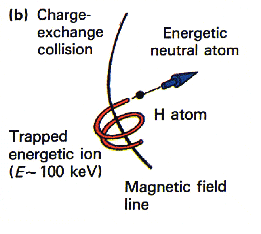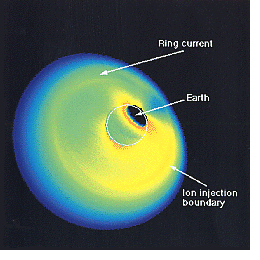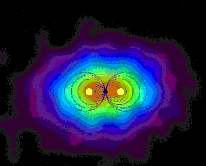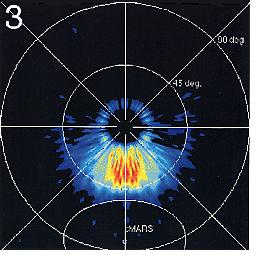ASPERA-3
Energetic Neutral Atom (ENA) Imaging
Basic Concept
The co-existence of an energetic charged particle population (solar
wind, magnetospheric plasma) and a planetary neutral gas leads to
interaction, e.g., through charge-exchange:
A+(energetic) + P(cold) => A(energetic) + P+(cold)
 In contrast to charged particles, ENAs are no longer influenced by
electromagnetic fields and propagate on straight paths from the source
to the observer. Directional detection of ENAs yields a global image
of the interaction and by complex inversion techniques properties of
the source populations can be deduced.
In contrast to charged particles, ENAs are no longer influenced by
electromagnetic fields and propagate on straight paths from the source
to the observer. Directional detection of ENAs yields a global image
of the interaction and by complex inversion techniques properties of
the source populations can be deduced.
ENA production mechanisms in space plasmas comprise:
-
Charge - exchange reaction with atmospheric / exospheric gases
-
Sputtering of planetary atmospheres
-
Backscattering from the planetary atmospheres (ENA albedo)
-
Sputtering from planetary surfaces
-
Ion neutralization / sputtering on dust particles
-
Recombination (CMI)
ENA Imaging Applications
 The
The  IMAGE mission successfully proved that ENA imaging can provide global views of plasma processes (substorm particle injections, ring current distribution and dynamics) in the Earth's Magnetosphere. IMAGE mission successfully proved that ENA imaging can provide global views of plasma processes (substorm particle injections, ring current distribution and dynamics) in the Earth's Magnetosphere.
 The
The  MIMI instrument on Cassini provided ENA images of the Jupiter - Io Torus system. MIMI instrument on Cassini provided ENA images of the Jupiter - Io Torus system.
 The simulated ASPERA-3 ENA response shows that the solar wind - exosphere interaction processes at Mars can be globally imaged in ENA.
The simulated ASPERA-3 ENA response shows that the solar wind - exosphere interaction processes at Mars can be globally imaged in ENA.
|
